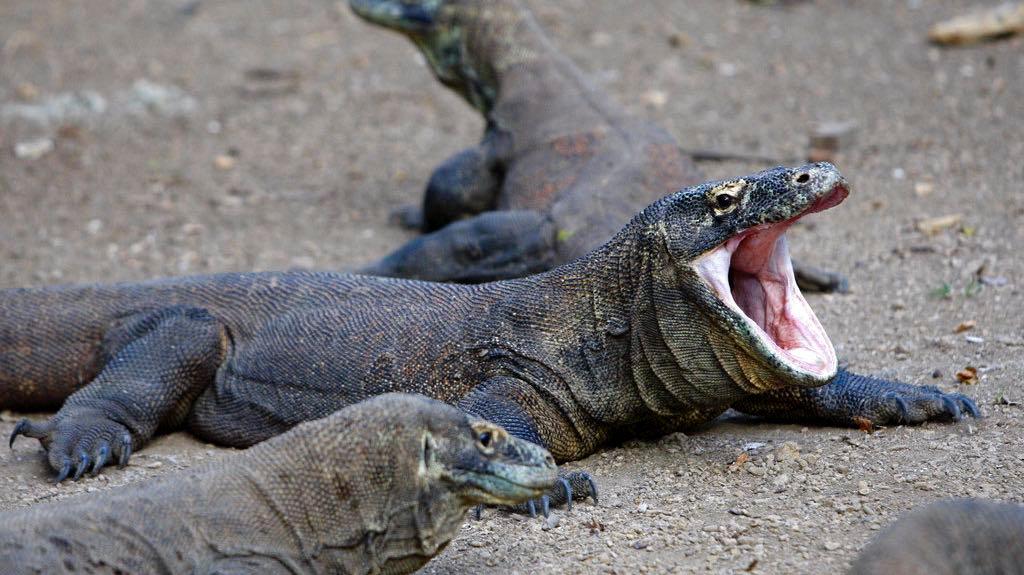The Komodo dragon lives up to its name: nearly 200 pounds of lizard, 8 feet from tail to tongue, with teeth like a shark.
Its bite implants venom that can stop your heart within hours. That’s if you don’t bleed out first. The creature tends to grip and rip, sinking jaws into prey and tearing off limbs.
But its fearsome reputation is exactly what makes the beast so attractive to a certain type of tourist — one willing to pay good money for a selfie with a so-called “dragon” in the background.
Related: Pangolin smuggling: The next coronavirus time bomb?
Charging foreigners for an encounter with these giant lizards is a niche industry in Indonesia’s Flores Island and its environs. This is the natural habitat of the Komodo dragon.
Fewer than 6,000 are left. Yet, in recent years, hundreds of thousands of tourists have surged into the area annually — and many crave an encounter with a Komodo dragon. That’s way too much contact for an animal classified as “vulnerable,” a diagnosis preceding “endangered” status.
So, officials have a plan. While the tourism boom is on pause — thanks to the COVID-19 pandemic — it will proceed with a plan to build a sleek new facility in Komodo National Park. In lieu of herding in backpackers, the project will target a smaller class of “premium” tourists, charging them roughly $1,000 per head.
Related: Anti-poverty program in Indonesia also helps save forests, study shows
A park charging wealthy travelers to behold massive, ancient lizards? Comparisons to “Jurassic Park” are inevitable. But the architects seem to be leaning into the allusion — scoring a video mock-up of the park with the orchestral “Jurassic Park” theme song.
This has handed ammunition to activists who note the movie is, in fact, about the calamity that follows when humans meddle with nature.
“’Jurassic Park,’ really? This is a mistake. I really don’t understand what the government is thinking.”
“’Jurassic Park,’ really?” said Aloysius Suhartim Karya, a local tour operator, activist and former park ranger at Komodo National Park. “This is a mistake. I really don’t understand what the government is thinking.”
Fears surrounding this project have nothing to do with dragons running amok. What environmentalists fear, Aloysius says, is that the park will be a harbinger of “ecocide” for the lizards.
Related: Indonesia’s newest Gen Z craze? Marrying someone you’ve never even dated.
“This island is a diamond of Indonesia,” he said. “It’s beautiful as it is — real and pure — not because of super-premium amenities. Now, they want to turn it into a zoo.”
Mowing down trees to build the park, Aloysius says, will wipe out the habitat for lizards and their prey. Opening a cafeteria on-site will suffuse the air with odd smells — scrambling the senses of Komodo dragons, which can detect scents from miles away.
“It’s safe for people. But it’s not safe for the animals.”
“It’s safe for people,” Aloysius said. “But it’s not safe for the animals.”
An official contacted by Komodo National Park did not respond to The World’s request for comment. Tourists are currently forbidden from the park. On Facebook, the park’s head officer tells tourists to “stay at home, we’ll keep the dragons safe for you.”
Cranes and trucks are already busy constructing a site that, according to architects’ drawings, will have sloping terraces looking down on a man-made, palm-studded island — one crawling with Komodo dragons.
Related: Does Thailand have a monkey labor problem?
Before COVID-19 swept the globe, tourists could pay guides to lead them into the jungle to find Komodo dragons lazing about or chewing on a wild boar carcass. Attacks against people are rare, though the guides must carry wooden sticks to keep the beasts away from tour groups.
Komodo National Park officials contend that its “Jurassic Park” project will not ruin the landscape. “We haven’t cut down a single tree,” the park’s top officer claimed.
But a leaked photo from the site has delivered a public relations hit that may be hard to shake. It appears to show a Komodo dragon staring down a truck loaded with metal rebar — and a few skittish-looking construction workers who’ve absconded to the roof.
“This photo,” Aloysius said, “is telling the story. The Komodo dragon does not need humans to protest. They are reacting on their own, seeing their habitat is destroyed, and they are getting angry.”
Our coverage reaches millions each week, but only a small fraction of listeners contribute to sustain our program. We still need 224 more people to donate $100 or $10/monthly to unlock our $67,000 match. Will you help us get there today?
